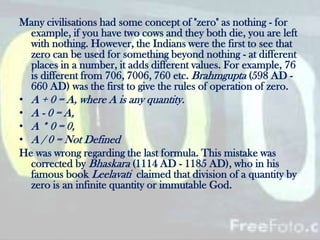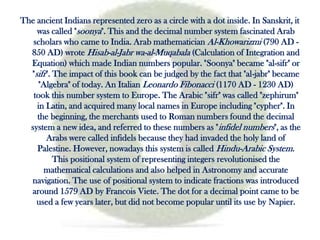The story of Zero
- 1. Mathematics Assignment -Rachel Elizabeth Thomas X-B Roll no. 23
- 3. Perhaps the most fundamental contribution of ancient India to the progress of civilisation is the decimal system of numeration including the invention of the number zero. This system uses 9 digits and a symbol for zero to denote all integral numbers, by assigning a place value to the digits. This system was used in Vedas and Valmiki Ramayana. Mohanjodaro and Harappa civilisations (3000 B.C.) also used this system. The ancient Egyptians (5000 B.C.) had a system based on 10, but they didn't use positional notation. Thus to represent 673, they would draw six snares, seven heel bones and three vertical strokes. Babylonians in Mesopotamia (3000 B.C.) had a sexagesimal system using base 60. Greeks and Romans had a cumbersome system (try to write 2376 in Roman numerals).
- 4. Many civilisations had some concept of "zero" as nothing - for example, if you have two cows and they both die, you are left with nothing. However, the Indians were the first to see that zero can be used for something beyond nothing - at different places in a number, it adds different values. For example, 76 is different from 706, 7006, 760 etc. Brahmgupta (598 AD 660 AD) was the first to give the rules of operation of zero. âĒ A + 0 = A, where A is any quantity. âĒ A - 0 = A, âĒ A * 0 = 0, âĒ A / 0 = Not Defined He was wrong regarding the last formula. This mistake was corrected by Bhaskara (1114 AD - 1185 AD), who in his famous book Leelavati claimed that division of a quantity by zero is an infinite quantity or immutable God.
- 5. The ancient Indians represented zero as a circle with a dot inside. In Sanskrit, it was called "soonya". This and the decimal number system fascinated Arab scholars who came to India. Arab mathematician Al-Khowarizmi (790 AD 850 AD) wrote Hisab-al-Jabr wa-al-Muqabala (Calculation of Integration and Equation) which made Indian numbers popular. "Soonya" became "al-sifr" or "sifr". The impact of this book can be judged by the fact that "al-jabr" became "Algebra" of today. An Italian Leonardo Fibonacci (1170 AD - 1230 AD) took this number system to Europe. The Arabic "sifr" was called "zephirum" in Latin, and acquired many local names in Europe including "cypher". In the beginning, the merchants used to Roman numbers found the decimal system a new idea, and referred to these numbers as " infidel numbers", as the Arabs were called infidels because they had invaded the holy land of Palestine. However, nowadays this system is called Hindu-Arabic System. This positional system of representing integers revolutionised the mathematical calculations and also helped in Astronomy and accurate navigation. The use of positional system to indicate fractions was introduced around 1579 AD by Francois Viete. The dot for a decimal point came to be used a few years later, but did not become popular until its use by Napier.





